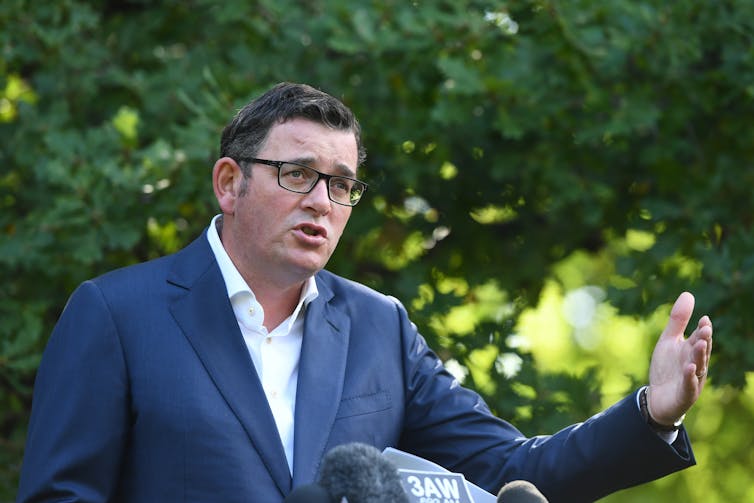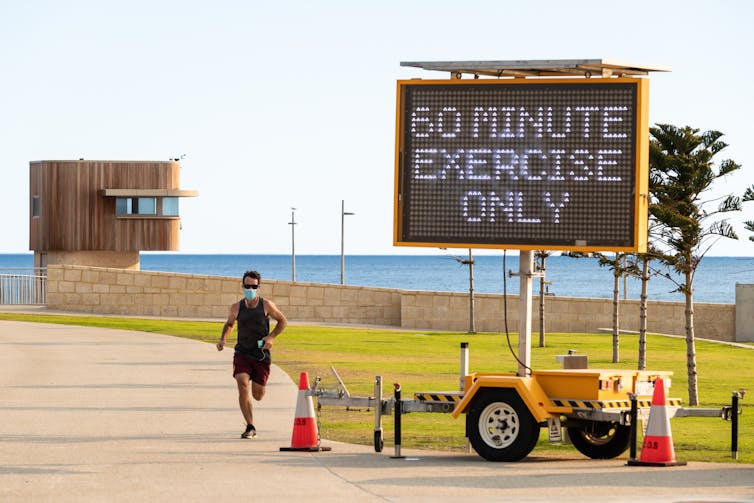Source: The Conversation (Au and NZ) – By Catherine Bennett, Chair in Epidemiology, Deakin University
Victorian Premier Daniel Andrews announced today the state’s five-day circuit-breaker lockdown would end at midnight tonight. The state’s health department reported zero new cases overnight from nearly 40,000 tests — the highest number of daily tests recorded in Victoria since the start of the pandemic.
Under the latest changes:
- the “four reasons to leave your home” rule will lift
- so does the 5km travel limit
- masks are still mandatory indoors when away from home
- masks are still mandatory outdoors when you can’t physically distance
- schools, hospitality and retail can reopen on Thursday
- household gatherings will be restricted to five guests (but 20 outdoors).
Around 3,400 close contacts remain in isolation, some of whom may yet return positive tests before the end of their quarantine period.
Victoria’s lockdown is the latest in a string of recent shutdowns, following similar circuit-breakers in South Australia, Queensland and Western Australia.
Andrews said a five-day lockdown is “infinitely better” than taking a chance and ending up with a five-week lockdown or worse.But in truth, we don’t know for sure what that chance is.
The fact Victoria uses comprehensive “contacts of contacts” tracing means we have rich data to explore how testing and tracing would stand up under more dire transmission scenarios involving the UK variant and a multi-case seeding event.
Mapping case and contact quarantine timing and overlaying this with various transmission scenarios will allow us to learn more from this contained outbreak. We can create virtual situations where additional close contacts are infected and learn whether tracing of their contacts would still have contained the outbreak.
That would generate a deeper understanding of when we might need to back up our contact tracing with a lockdown or other measures, and identify a range of options that could achieve this. This will give policy-makers options beyond the dichotomy of business as usual or lockdown, so we do as much as is needed, and no more.
This isn’t a criticism of short, sharp lockdowns used so far. But let’s not miss this opportunity to interrogate the data and learn from it. The government, and the public, need more guidance on what should trigger different levels of public health restrictions.
The lockdown was a safety net
So far, all cases in Melbourne’s latest outbreak are associated with one of the following: the initial exposures at the Holiday Inn (authorities believe this occurred on February 3 or 4); a worker’s spouse; or a private dinner held on February 6. This represents two generations of spread from the original returned traveller (whose partner and child were also infected and included in health department counts).

All transmission to current known cases therefore happened before the lockdown. All of the highest-risk close contacts of these cases, who have since tested negative, were in quarantine before the lockdown too.
The ring of negative cases tells us the risk of infection in more casual contacts is extremely low.
Like the recent local lockdowns in Queensland and WA, Victoria’s lockdown does not seem to have contributed to containment. As it turned out, the outbreak was effectively controlled by rapid case detection, testing, tracing and isolation by the time lockdown came into effect.
This is great news and a credit to public health teams and the public who came forward for testing and quarantine. But what if the epidemiology had played out differently? We should aim to deepen our understanding, to learn more about whether, and when, we need circuit-breakers in the future.
Read more: Perth is the latest city to suffer a COVID quarantine breach. Why does this keep happening?
We can’t conclude lockdown was a success… yet
We can analyse the impacts the current, and other, lockdowns would have had under higher-transmission situations by overlaying actual contact tracing data with different contact infection scenarios. Victoria provides the richest data for this as the second ring of contacts of cases are quarantined routinely, which means we can treat more of the primary contacts as if they had become actual cases and then upgrade transmission risk among their own contacts.
We can also use this opportunity to investigate the actual change in the number of close contacts that lockdown brings. In the current outbreak, Victoria broadened the definition of “close contact” to anyone in contact with a case, or a venue where the case had been. Pre-lockdown, this took us from 59 close contacts, not quite 10 per original Holiday Inn case, to 3,400 including Terminal 4 at Melbourne Airport.
Using broad definitions of a close contact is a very cautious approach, and pushes us towards lockdowns faster to keep tracing manageable. So this element of our response also needs to be reviewed to identify a safe but proportionate level of contact to deem “close contact”.

Circuit-breaker lockdowns act as safety nets. It’s innately difficult to evaluate whether they’re really necessary. In Victoria, contact tracing stood up to the test. And thankfully, cases were either not very infectious, or by chance didn’t mix with others in a way that led to widespread transmission before our public health response was wrapped around it.
But we can create scenarios that offer a sterner test of our contact-tracing capacity to determine whether the safety nets might be required, what they should look like, and when they would need to be initiated to be effective.
Our circuit-breakers have progressively become more expansive — Queensland’s lasted three days and only covered Greater Brisbane, whereas Victoria’s was five days and statewide. There’s a danger this trend will continue on the presumption that lockdown makes a crucial difference to the outcome.
The truth is that our success in containing these outbreaks, and the luck in not having higher levels of infection, still leaves us with work to do to evaluate the place of circuit-breakers in Australia.
– ref. Victoria’s statewide lockdown ends. Data can tell us what to do next time – https://theconversation.com/victorias-statewide-lockdown-ends-data-can-tell-us-what-to-do-next-time-155450







